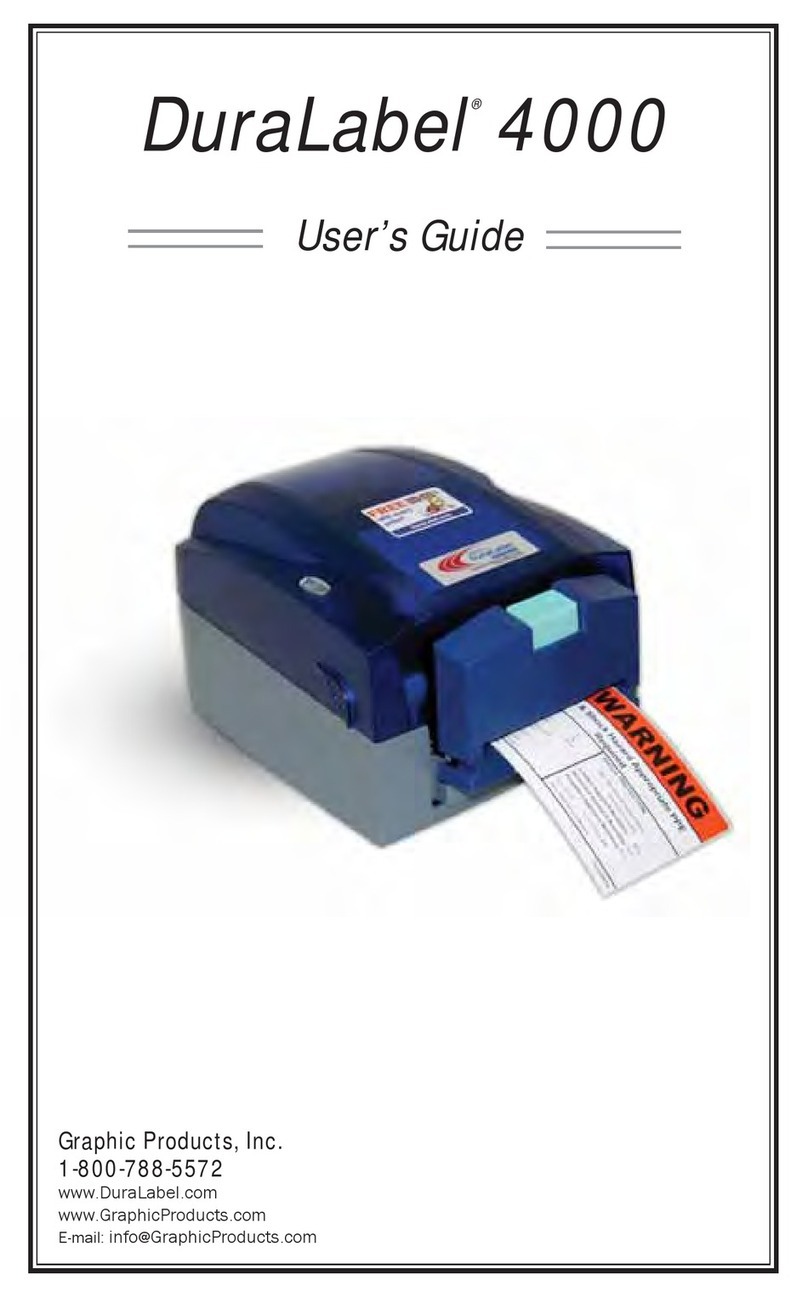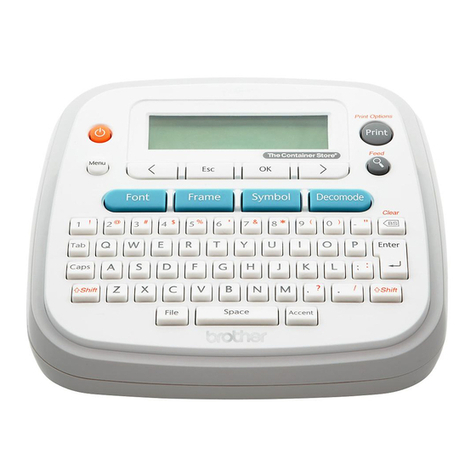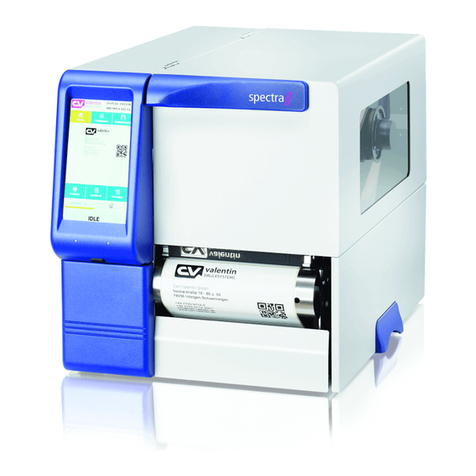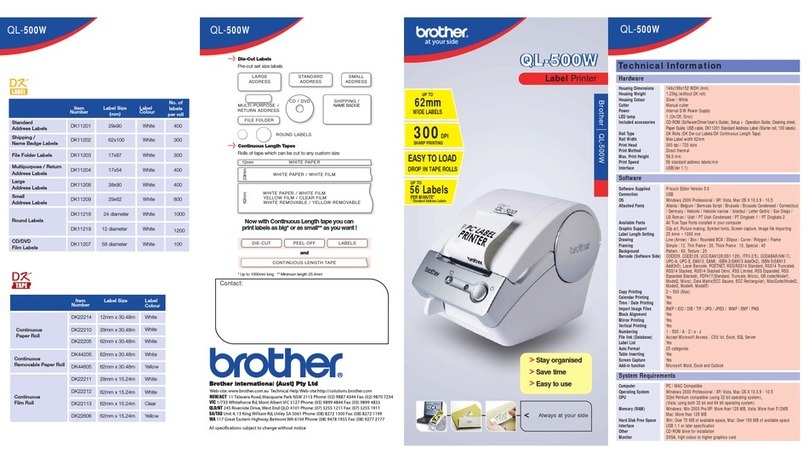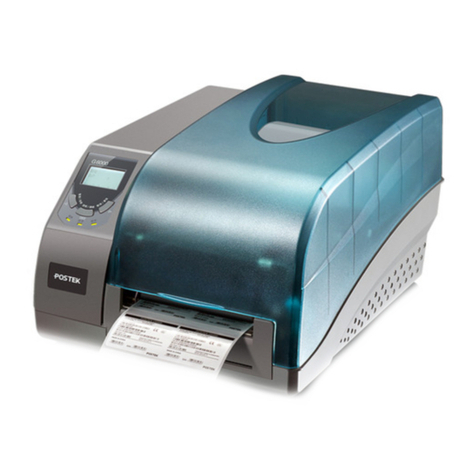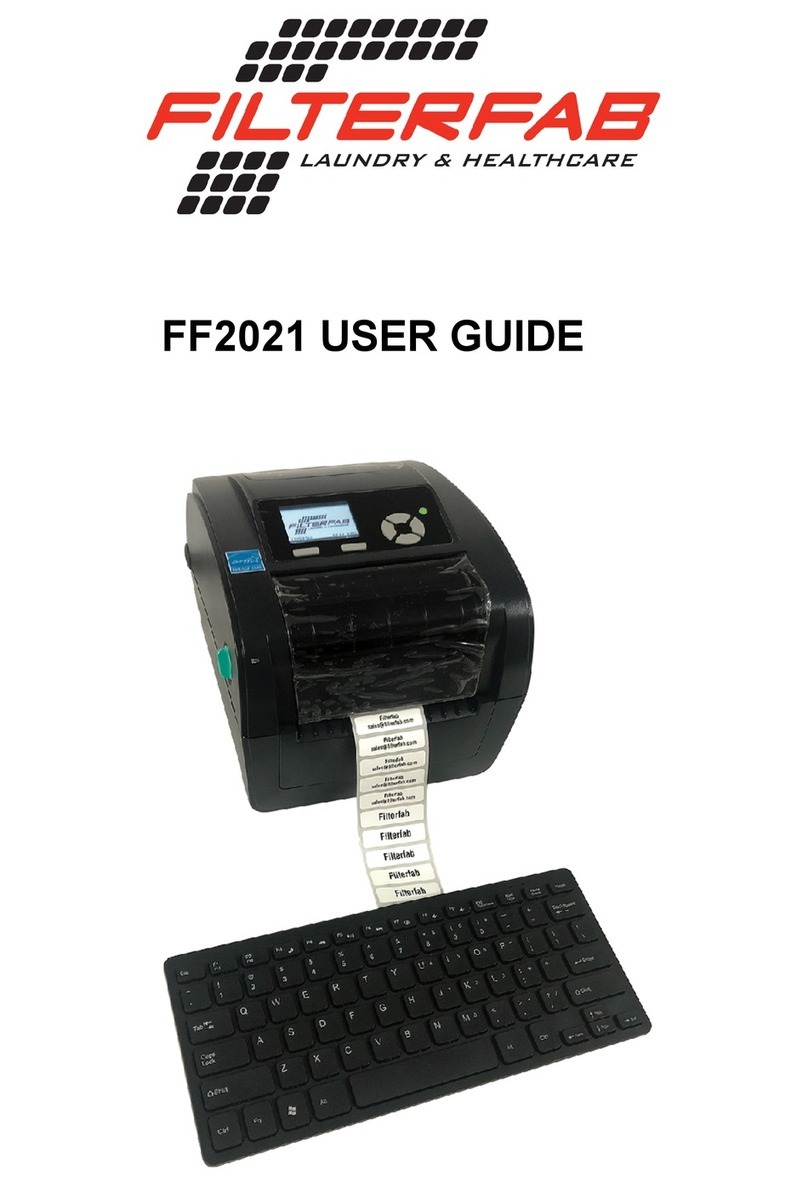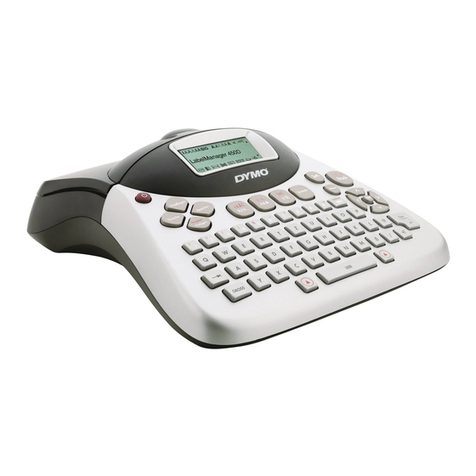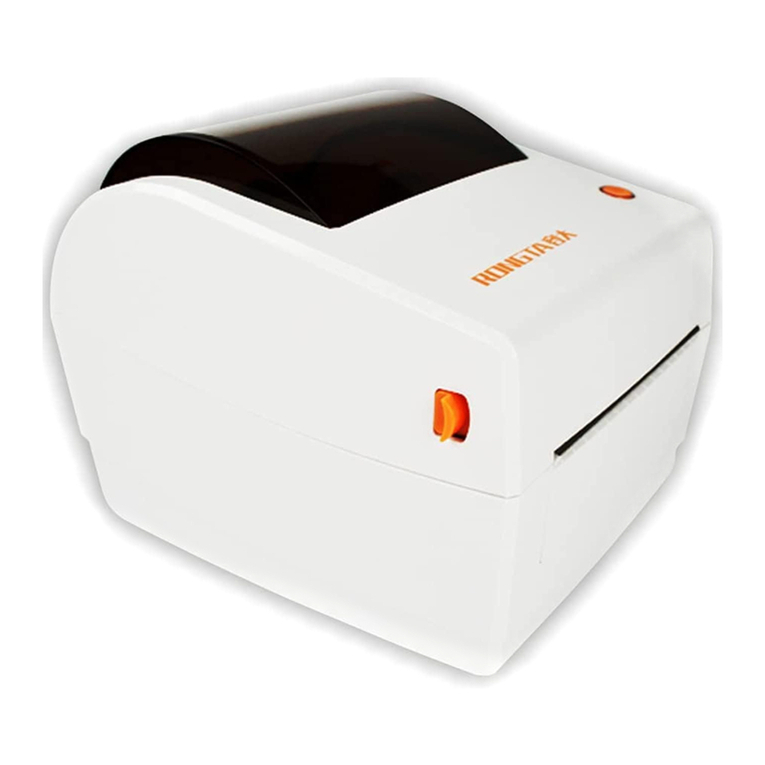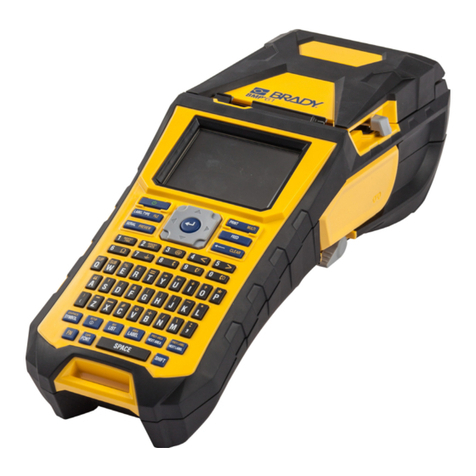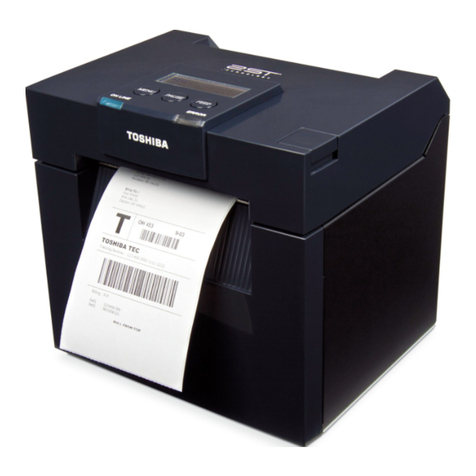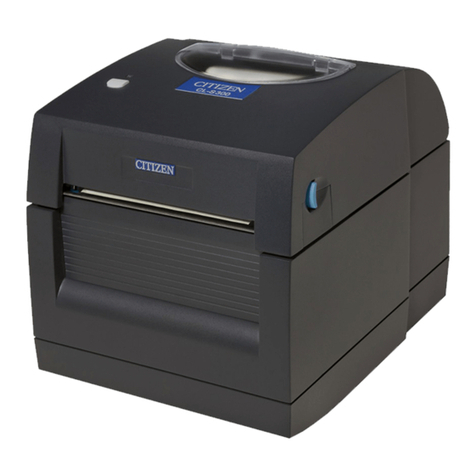Printronix Auto ID T8204 User manual

Online Data Validator 2D User’s Manual
T8204 and T8304 Printers

Printronix Auto ID Technology, Inc. makes no representations or warranties of any kind regarding this
material, including, but not limited to, implied warranties of merchantability and fitness for a particular
purpose. Printronix Auto ID Technology, Inc. shall not be held responsible for errors contained herein or
any omissions from this material or for any damages, whether direct, indirect, incidental or consequential,
in connection with the furnishing, distribution, performance or use of this material. The information in this
manual is subject to change without notice.
This document contains proprietary information protected by copyright. No part of this document may be
reproduced, copied, translated or incorporated in any other material in any form or by any means, whether
manual, graphic, electronic, mechanical or otherwise, without the prior written consent of Printronix Auto ID
Technology, Inc.
COPYRIGHT © 2018 PRINTRONIX AUTO ID, INC. All rights reserved.
Trademark Acknowledgements
T8000 is a trademark of Printronix Auto ID Technology, Inc.
Communication Notices
This equipment has been tested and found to comply with the limits for a Class A digital device, pursuant
to Part 15 of the FCC Rules. These limits are designed to provide reasonable protection against harmful
interference in a residential installation. This equipment generates, uses, and can radiate radio frequency
energy and, if not installed and used in accordance with the instructions, may cause harmful interference
to radio communications. However, there is no guarantee that interference will not occur in an installation.
If this equipment does cause harmful interference to radio or television reception, which can be determined
by turning the equipment off and on, the user is encouraged to try to correct the interference by one or
more of the following measures:
• Reorient or relocate the receiving antenna.
• Increase the separation between the equipment and receiver.
• Connect the equipment into an outlet on a circuit different from that to which the receiver is connected.
• Consult the dealer or an experienced radio/TV technician for help.
Unauthorized changes or modifications could void the user’s authority to operate the equipment.
This device complies with part 15 of the FCC Rules. Operation is subject to the following two conditions:
(1) this device may not cause harmful interference, and (2) this device must accept any interference
received, including interference that may cause undesired operation.
Any change or modification to this product voids the user’s authority to operate it per FCC Part 15 Subpart
A Section 15.21 regulations.
Canada
This Class A digital apparatus complies with Canadian ICES-003 and RSS 210.
Cet appareil numérique de la classe A est conforme à la norme NMB-003 du Canada.
Operation is subject to the following two conditions: (1) this device may not cause interference, and (2) this
device must accept any interference, including interference that may cause undesired operation of the
device.

CE Notice (European Union)
Marking by the CE symbol indicates compliance of this Printronix system to the EMC Directive and the
Low Voltage Directive of the European Union. Such marking is indicative that this Printronix system meets
the following technical standards:
• EN 55022 — “Limits and Methods of Measurement of Radio Interference Characteristics of Information
Technology Equipment.”
• EN 55024 — “Electromagnetic Immunity Requirements for Information Technology Equipment”
• EN 60950 — “Safety of Information Technology Equipment.”
Printronix Auto ID Technology, Inc. cannot accept responsibility for any failure to satisfy the protection
requirements resulting from a non-recommended modification of the product, including the fitting of
non-Printronix option cards.
This product has been tested and found to comply with the limits of Class A Information Technology
Equipment according to European standard EN 55022. The limits for Class A equipment were derived for
commercial and industrial environments to provide reasonable protection against interference with
licensed communication devices.
CE Symbol
Taiwan
This is a Class A product. In a domestic environment, this product may cause
radio interference in which case the user may be required to take adequate
measures.
WARNING
型 式 合 格 功 電
,
可
,
司 、 或 使 用 者 不 得 自 更
、 加 大 功 或 更 原 性 功 。
功 電 使 用 不 得 全 干 擾 合 通
;
現 有 干 擾 現
,
用
,
並 善 干 擾 得 使 用 。 前 項 合 通
,
指 電 規 作 業
電 通 。 功 電 須 受 合 通 或 工 業 、 科 學 療 用 電 波 輻 性 電
干 擾 。

Compliance Statements
The Printronix Online Data Validator 2D gathers data per the ISO/ANSI method of verification to perform
practically all the industry standard bar code quality parameter calculations. These include all ISO/ANSI
method parameters for 1-D and 2-D barcodes along with decoding the symbol.
Reflectance Compliance – 660 nm Wavelength (Red) Light
The reflectance values embedded in the calibration symbol supplied with each ODV2D are measured
using a calibrated ISO compliant verifier.
ISO/ANSI Method Compliance
The Printronix ODV2D gathers data and performs all ISO/ANSI method parameter calculations per the
ISO/IEC 15416 (1-D) and ISO/IEC 15415 (2-D), and ANSI X3.182-1990 methodologies with a few special
considerations and exceptions. The ODV2D also conforms to ISO/IEC 15426-1 and 15426-2 per the
requirements specified in Section 2 of both documents, with some exceptions.
The exceptions and considerations are related to the instrument’s design and mission. The design
incorporates a proprietary image scanner that has been assembled with a fixed focal length to produce a
calibrated dot resolution for measuring 10mil of larger minimum X-dimensions. Further, the measurement
accuracy of some grading parameters may be lower than identified in the standard.
The mission is to not only analyze bar code quality, but also to detect any printer failures, process failures
or media problems. For maximum performance and to conform to quality specifications, a fixed mounting
distance and angle are required.
An image scan resolution that can detect errors of the particular print method is highly recommended.
The scan resolution used may or may not correspond to the recommendations in various specifications
that it be related to the X dimension of a particular symbol, but instead correspond to the printer’s
resolution or some other parameter(s) critical in the application. A major philosophy of an on-line
verification system is; if the printer and/or process is operating correctly and the media has proper
reflectance properties, the best print quality for that particular print method and material is achieved by
definition.
Special Considerations
1. Final system tests are performed at the proper focus distance and at an angle of 27 degrees. Units
with common focus distances are checked to yield analysis results within 10% of the ISO verifier
accuracy requirements.
2. All ODV2D’s use the same light source with a wavelength of 624 +/- 10 nm. Therefore, any ISO/ANSI
overall symbol grade calculated by an ODV includes 624 as the wavelength portion of the grade.
Exceptions to the ISO/ANSI Method
The Defects calculation does not include the quiet zone area. A separate quiet zone check is implemented
to more easily isolate print problems vs. setup problems in an on-line environment.

Table of Contents
Communication Notices...................................................... 2
Compliance Statements ..................................................... 4
ODV-2D Usage .............................................................. 7
Overview ............................................................................ 7
Capability Highlights ............................................................................................ 7
Supported Barcodes ............................................................................................ 8
Operational Parameters ...................................................................................... 8
Enable the ODV-2D ............................................................ 9
Calibration ........................................................................ 10
Purpose of Calibration ....................................................................................... 10
Validation Demo Page ....................................................................................... 10
Operation ..................................................................... 11
ODV-2D Menu Overview ............................................. 11
Grading Parameters ......................................................... 12
Grading A-F ....................................................................................................... 12
ISO versus Non-ISO .......................................................................................... 12
Parameter Applicability ...................................................................................... 13
Configuring the ODV-2D ............................................ 14
Enabling and Disabling ...................................................................................... 14
Note on Energy Star .......................................................................................... 14
Checking the Firmware Revision Number ......................................................... 14
Validator Reporting ............................................................................................ 14
Control Submenu ............................................................................................... 15
Symbology Submenu ........................................................................................ 22
Grading Submenu ............................................................................................. 25
Diagnostics Submenu........................................................................................ 32
Statistics Submenu ............................................................................................ 36
Print Speed Limits ............................................................................................. 38
Page Size and Barcode Limits .......................................................................... 38
Minimum Code Height ....................................................................................... 38
Data Matrix Complexity ..................................................................................... 38
On-Demand Printing .......................................................................................... 38
PTX_SETUP Control ......................................................................................... 39

Bar Code Failures ............................................................ 41
Process for 1-D Barcode Analysis ..................................................................... 41
Bad Bar Code Error Detection ........................................................................... 42
Missing Bar Code Error Detection ..................................................................... 42
Validator Action (Error Action) ........................................................................... 42
Troubleshooting ........................................................... 46
Error Messages ................................................................................................. 46
Maintenance ................................................................ 54
Software License Agreement ........................................... 55
Open Source Acknowledgements .................................... 57
Angstrom Linux .................................................................................................. 57
Linux Boot Loader ............................................................................................. 57
Aptina Video Driver Module ............................................................................... 58
GNU C Libraries ................................................................................................ 58
OpenCV ............................................................................................................. 58
ZXing Barcode Reader ...................................................................................... 59
Mongoose Web Server ...................................................................................... 59
Open Source Licenses ..................................................... 61
GPL 2.0 ............................................................................................................. 61
GPL 3.0 ............................................................................................................. 64
LGPL 3.0 ........................................................................................................... 71
Apache 2.0 ........................................................................................................ 73
Printronix Auto ID Customer Support Center .................... 76
Corporate Offices .............................................................................................. 77

7
ODV-2D Usage
Overview
The online data verifier/validator for one and two-dimensional barcodes (ODV-2D) is a fully integrated bar
code camera scanning device mounted to the printer above the paper exit. When activated, it records the
image of the printed output looking for bar codes in any right-angle orientation (0°, 90°, 180°, 270°). When
it finds a bar code, it determines what type of bar code, confirms the data encoded, and provides the ISO
grading, performing both functions of validation and verification.
As the label passes under the camera, the ODV-2D grades the bar code, confirms the data printed
matches the data sent and sends a report to the printer. The printer response is determined by the
ODV-2D settings, explained in “Configuring the ODV-2D”.
Capability Highlights
The ODV-2D system is a camera-based system with LEDs that flash at a given frequency to illuminate the
surface of the label as it exits the printer. A sensor is used to record slices of the image as the output
moves past the lens and then stitches them together for analysis. Thus, the entire image is recorded by the
ODV-2D for analysis which allows verification of 1-D barcodes in ladder and picket fence orientations and
2-D barcode grading.
The summary of capabilities are as follows:
• The ODV-2D is supported on the T8000 4” models (T8204 and T8304).
• The ODV-2D supports all orientations of barcodes (0°, 90°, 180°, 270° degrees).
• The ODV-2D supports full ISO-based grading for PDF417, DataMatrix, and QR symbologies.
• Barcodes printed as graphics (Win Drivers, WYSIWIG label programs) do not require additional setup.
The printer will dynamically inspect and identify all properly scaled graphic barcodes.
• The ODV-2D firmware can be downloaded via the printer or via ODV-2D ethernet webpage.
• The ODV-2D has an Ethernet port (hidden by cover plate) for access to an onboard webpage that
provides:
o Calibration and Alignment Wizards
o Trending Analysis
o The ability to capture and view images from the camera
o Advanced Diagnostics

8
Supported Barcodes
Table 1 lists the symbologies supported by the ODV-2D. Some of these will be supported in future
maintenance releases
Table 1 Symbologies Supported
Feature
ODV-2D
Code 39
Yes
Interleaved 2/5
Yes
Code 93
Yes
Code 128
Yes
UPC/EAN
Yes
UPC/EAN Supplemental
Yes
PDF417
Yes
PDF417 Limited
Future
Micro PDF417
Future
DataMatrix (Square)
Yes
DataMatrix (Rectangle)
Yes
QR
Yes
Aztec
Future
Operational Parameters
The design parameters of the validator are as follows:
• The ODV-2D can support labels of 24 inches maximum.
• The ODV-2D can track the performance of up to 50 barcodes on a label.
• The ODV-2D can support 2-8 IPS setting for picket fence and 2-6 IPS for ladder.
• The ODV-2D requires a minimum narrow bar width of 10 mils (0.010 inch). This is equivalent to 2 dots
at 203 DPI or 3 dots at 300 DPI.
• The ODV-2D can support bar codes up to 0.10 inch in height (linear 1-D codes).
• Depending on the complexity of the form and number of barcodes, the printer may pause between
labels if required to complete the calculations on a given label.

9
Enable the ODV-2D
IMPORTANT If you make any changes to the default configuration menu items, you will be
prompted to save the configuration when you attempt to put the printer online. See
the Administrator’s Manual for more information.
Software can automatically detect an installed ODV-1 or ODV-2D validator when the printer is powered up.
This section focuses on the specifics of the ODV-2D but follows the same behavior as the ODV-1 except
with ODV-2D icons and menus. The state of the ODV-2D can be observed from the ONLINE screen as
shown in Figure 1 below.
• The ONLINE screen will show the “enabled” validator symbol under the model number when the
ODV-2D is installed AND enabled via the menu ODV-2D > Control > Validator Active.
• The ONLINE screen will show the “disabled” validator symbol under the model number when the
ODV-2D is installed and disabled via the menu ODV-2D > Control > Validator Active.
• If neither the ODV-1 nor ODV-2D is installed, then no validator symbol will be present on the ONLINE
screen.
• The Settings screen will use validator icons as follows:
o If neither the ODV-1 nor ODV-2D is installed, the greyed-out ODV-2D icon will be present.
o If the ODV-1 is installed, the color Validator 1-D icon will be present.
o If the ODV-2D is installed, the color ODV-2D icon will be present.
• Within the menu section, then the ODV-1 will use the heading Validator (e.g., Validator > Control) and
the ODV-2D will use ODV-2D (e.g., ODV-2D > Control).
Figure 1 Online Screen and ODV-2D Icon
Once the ODV-2D is installed, the ODV-2D section under Settings can be selected and the ODV-2D
configured. However, it may not be enabled by default:
• If the printer is powered up with the menu Configs > Control > Power-Up Config set to Factory, the
ODV-2D > Control > Validator Active will be set to “Enable” automatically.
• If the printer is powered up with Configs > Control > Power-Up Config to something other than Factory,
the ODV-2D > Control > Validator Active is set to “Disable”.
To enable the ODV-2D, change the menu ODV-2D > Control > Validator Active to “Enable” and save the
configuration as described in the Administrator’s Manual.
IMPORTANT Do not enable or disable the ODV-2D with data in the buffer. See “Resetting ODV-2D
Data”.

10
Calibration
The calibration procedures should only be performed by trained personnel. Therefore, the procedures are
defined separately. Contact your Printronix Service Representative or provider for more information.
Purpose of Calibration
Calibration is needed for the following three purposes:
• To make sure the ODV-2D unit is functioning properly. This requires the use of a GS1 calibration
plaque that was supplied with your unit.
• To make sure the ODV-2D unit is aligned properly with the printer. The ODV-2D unit is connected
via a bracket and fine tuning may be required if the unit is bumped or transported to another
location.
• To make sure the ambient lighting conditions are considered when grading barcodes.
Validation Demo Page
The 2-D bar code validation demo page allows you to test or demonstrate proper validator operation
without a host computer. This page contains several bar code symbologies (including 2-D) and is
recommended for 4x6 labels.
NOTE: If the menu Media > Image > Label Width or Media > Image > Label Length or Media > Image >
Label Width is set to something other than 4” or 6”, respectively, then some of the barcodes may
not print. This does not invalidate the test, but does not allow the entire scan width to be verified. If
Label dimensions are too small, no barcodes will be printed.
To print and validate the bar code validation demo page:
1. Load the factory default configuration. (Refer to the Administrator’s Manual.)
2. Set ODV-2D > Control > Validator Active to “Enable”.
3. Set Sensors > Control > Gap/Mark Sensor to “Gap”.
4. Load media.
5. Using Sensors > Calibrate > Auto Calibrate or by selecting in the Home screen, run Auto
Calibrate for proper gap sensing.
6. Edit the menu Tools > Print Tests > Run Tests. If the panel is locked, press the UP+DOWN ARROW
keys simultaneously to unlock.
7. Find the printer test named “Barcode Demo 2D” and press the ENTER key.
8. The printer will return ONLINE automatically and print one demo page.
9. To demonstrate a bad bar code reading, block the scanning beam with an opaque object while the bar
code moves under the beam. When you block the beam, the ODV-2D will generate a reading error and
will perform a default error action. The default setting for ODV-2D > Control > Validator Action is “Retry
Form”. Using the factory default settings, the printer will pull the label with the bad barcode back,
overstrike the entire label, reprint the barcodes on the next label, and then stop.
10. Press the PAUSE key to take the printer OFFLINE.
11. Lock the panel again using the UP+DOWN ARROW keys.
12. Press the PAUSE key to place the printer back ONLINE.

11
Operation
ODV-2D Menu Overview
The ODV-2D section is structured into four submenus as follows:
• The Control submenu is used to configure how the ODV-2D will operate with respect to the results
provided by the validator. Those menus are described below.
• The Symbology submenu is used to configure which orientations and symbologies will be graded and
which will be ignored.
• The Grading submenu is used to configure grading criteria of the barcodes found by the validator.
Those menus are described below.
• The Diagnostics submenu is used to run test procedures to help determine the accuracy and trou-
bleshoot the validator. Those menus are described below.
• The Statistics submenu is general read-only and used to gather and report statistics on how the val-
idator is reporting on print jobs sent to the printer. Those items are described below.
The ODV-2D menu structure and its defaults are summarized in Figure 2 and Figure 3.
Figure 2 ODV-2D Section and Submenus
ODV-2D
Control
Grading
(ISO) Default
Validator
Active
* Enable
Auto
Report
* Disable
Auto
Report Time
* 1 seconds
Telemetry
Path
* Disabled
Telemetry
Data
* Short Report
Validator
Action
* Retry Form
Quiet
Zones
* Disable
Skip
Labels
* Minimum
Overstrike
Style
* Grid
Comm
Error
* Clearable
Label
Save
* Disable
Max Retry
Action
* Dump Form
Num
Retry
* 5
Continued
Overall
Grade
* 0.0
Return
Data
* Disabled
Symbology Orientation
* All
Graphics
Search
* Enable
Code 39
* Enable
Code 128
* Enable
Interleaved
2/5
* Enable
Code 93
* Enable
Codabar
* Enable
UPC/EAN
* Enable
PDF417
* Enable
Data Matrix
* Enable
QR Code
* Enable
Data
Verify
* Disable
Comm
Timeout
* 25 seconds

12
Figure 3 Validator Section and Submenus, Continued
Diagnostics
Statistics
Scan
Report
Scan
Profile
Profile
Horiz Mag
* 1
Print
Settings
Clear
Data
Good
Barcodes
Good
Forms
Overstrike
Forms
Average
BWD
Last
BWD
Validator
F/W
Validator
Validator
Report
Print
Bullseye
Print
Dots
Serial Num.IP
Address
MAC
Address
Decodability
* 37%
Percent
Decode
* 0%
Defects
* 21%
Overall
Grade
* 0.0
Modulation
* 0%
EC Min
* 15%
Rmin
* 50%
Symbol
Contrast
* 0%
Grading
(Non-ISO)
Global
Threshold
* 50%
Fixed Pat.
Damage
* 3.0
Axial
Non-Uniform
* 3.0
Grid
Non-Uniform
* 3.0
Unused
Error Corr.
* 50%
Codeword
Yield
* 64%
Data
Verify
* Disable
Grading Parameters
Grading A-F
Several ISO and traditional parameters are individually graded per the ISO and ANSI specifications, and
these individual grades are combined to make an overall ISO-compliant grade. The ODV-2D will always
fail any barcodes which have grades less than or equal to the value specified in the Overall Grade menu.
Instead of grade letters (A-F), numbers are used to allow for more resolution. ISO-compliant letter grades
correspond to numerical grades as shown in the table below.
Table 2 Grading Numerical Range
Letter Grade
Grade Numerical Range
A
3.5 - 4.0
B
2.5 - 3.4
C
1.5 - 2.4
D
0.5 - 1.4
F
0.0 - 0.4
ISO versus Non-ISO
In terms of grading the form, there are two different modes available based on the menu setting ODV-2D >
Grading > Grading Mode:

13
• ISO – In this mode, all grading parameters are based on ISO standards. Only the Overall Grade
menu is user adjustable to generate a fault. When this mode is selected all other menus in this
section are hidden and reset. The grading results are then based on the ISO specifications.
• Non-ISO – This mode allows the user to set custom failure thresholds on individual barcode
quality parameters. Changing individual quality parameters may lead to non-ISO standard
grading. It is recommended that only users that understand both the ISO standards and the end
user barcode quality requirements change any setting that affects the barcode quality parameters.
All quality parameter menus are visible and user adjustable in this mode
Parameter Applicability
Barcode verifiers use parameters dictated by industry standards for grading and reporting barcodes. The
table below shows a summary of the industry standard parameters used for barcode grading. While the
ODV-2D is limited to validation, it will implement the same ISO parameters for grading as shown in Table
3.
Table 3 Configurable Analysis Parameters
Parameter
1D
2D
Stacked
Matrix
Modulation
x
x
x
Symbol Contrast
x
x
x
Overall Grade
x
x
x
Rmin
x
x
ECmin
x
x
Defects
x
x
Decodability
x
x
Fixed Pattern Damage
x
Axial Nonuniformity
x
Grid Nonuniformity
x
Unused Error Correction Code
x
x
NOTE: Stacked Barcodes include PDF417. Matrix barcodes include DataMatrix, QR, and Aztec.

14
Configuring the ODV-2D
Configuring the validator is done by selecting the ODV-2D icon within the Settings section. The
ODV-2D comes equipped with a default setting for each configuration option, and it works without having
to change any of these options. However, in some cases it is necessary to adjust these options, which are
described below.
IMPORTANT If you are unable to select the ODV-2D icon or the icon is grey , then the validator
is not properly installed. Please contact the Printronix Customer Support Center.
IMPORTANT If you make any changes to the default configuration menu items, you will be
prompted to save the configuration. See “Auto Save Configuration” in the
Administrator’s Manual.
Enabling and Disabling
Software can automatically detect an installed validator when the printer is powered up. If the printer is
powered up with Configs > Control > Power-Up Config set to “Factory”, the ODV-2D icon can be selected
and ODV2-2D > Control > Validator Active is set to “Enable”.
If Power-Up Config. is not set to Factory, the ODV-2D icon can be selected, but ODV-2D > Control >
Validator Active is set to “Disable”. Set this menu to “Enable” and save the configuration as described in
the Administrator’s Manual. In the same manner, the validator can be disabled.
IMPORTANT Do not disable or enable the ODV-2D with data in the buffer. See “Resetting ODV-2D
Data” page 15.
Note on Energy Star
The menu System > Energy Star > Pwr Saver Active is by default enabled and System > Energy Star >
Pwr Saver Time is set to 5 minutes. Because Energy Star requires the ODV to be completely shut down,
the time to revive the ODV-2D can be more than 30 seconds which can be challenging for on-demand
applications. The user is recommended to either increase the Pwr Saver Time or disable Pwr Saver Active
menus if the revival time is not satisfactory.
Checking the Firmware Revision Number
For troubleshooting purposes, you may need to reference the ODV-2D firmware revision number. This can
be found in two different places within the Settings section:
• ODV-2D > Statistics > Validator F/W.
• Tools > About > Validator F/W.
Validator Reporting
After any completed print job or Bar Code Demo page, you can request a report from the printer which
describes the validation statistics since the printer was turned on, or since the last data reset (for
information on resetting data, see page 15.)
Requesting a Validator Report
This procedure prints a summarized validator report
1. Press the PAUSE key to take the printer OFFLINE.
2. If necessary, press the UP+DOWN ARROW keys at the same time to unlock the front panel.
3. Edit the menu Tools > Print Tests > Run Tests.
4. Find the printer test named “Valid. Report” and press the ENTER key.
5. Lock the panel again using the UP+DOWN ARROW keys.

15
6. Press PAUSE again to put the printer ONLINE.
Defining the Output Destination (Telemetry Path)
You may want to send a streaming flow of validation data to the PNE Auto ID Data Manager application
during the print job. By default, this function is disabled.
To enable this function, set the menu ODV-2D > Control > Telemetry Path to “Network Port”. The printer
then outputs the bar code analysis and underlying data from the validator to the PNE connected to the
network port so the validator data can be seen and analyzed with the optional remote management
software.
Sending Validation Data (Return Data)
You may want to send a streaming flow of validation data to an external device during the print job. By
default, this function is disabled.
To enable this function, set the menu ODV-2D > Control > Return Data to “Data+Grade” or
“Data+Grade+Fail”. The printer then outputs the bar code analysis and underlying data from the validator
to a device connected to the port defined in the System > Printer Mgmt > Ret. Status Port menu so the
ODV-2D data can be seen and analyzed.
Selecting the Type of Report (Telemetry Data)
The validator sends a report to the selected data output destination. There are three different options
controlled by the ODV-2D > Control > Telemetry Data menu:
• Short Report. Default setting. Provides the encoded failure cause or pass indication and the bar width
deviation, shown as a percentage.
• Full Report. Provides a completed report of all the data captured by the ODV-2D.
• Validation Mode. Provides the same data as the Short Report but adds the actual bar code data
scanned.
Resetting ODV-2D Data
The ODV-2D reports on all bar codes it detects since the last data reset. For example, you print a large
batch of labels with bar codes and then print a validator report. Then you print another batch of labels with
bar codes and print another report. The report will contain information on both batch jobs. However, if you
reset the ODV-2D data between batch jobs, the second report will only contain information on the second
batch job.
To reset Validator Data, execute the menu ODV-2D > Statistics > Clear Data.
Control Submenu
Several ODV-2D options which define specific parameters for certain print jobs can be set from the printer
configuration menu.

16
Validator Active
ODV-2D > Control > Validator Active
Software can automatically detect an installed validator when the printer is
powered up. If the printer is powered up with Configs > Control > Power-Up
Config set to “Factory”, the Validator icon can be selected and this option is
set to “Enable”.
If Power-Up Config is not set to Factory, the Validator icon can be selected,
but this option is set to “Disable”.
Disable
The ODV-2D is disabled and not active.
Enable
The ODV-2D is enabled and active.
Factory Default
Depends on Configs > Control > Power-Up Config
setting. See above.
IMPORTANT
Do not disable or enable the ODV-2D with data in
the buffer. See “Resetting ODV-2D Data”.
IMPORTANT
When exiting Power Saver Mode, about 120 sec-
onds is required to re-initialize ODV-2D. A mes-
sage will be displayed alerting the user of the de-
lay.
Auto Report
ODV-2D > Control > Auto Report
This function allows you to disable or enable an automatic validator report
printout after a batch job or Bar Code Demo page.
Disable
No automatic validator report is printed after the job.
Enable
The validator report is printed after the batch job. The
end of the batch is determined by either the EXECUTE
command or by timeout using ODV-2D > Control >
Auto Report Time to the desired value (1 to 10 sec-
onds).
Print&Clear
Same functionality as Enable with the validator statis-
tics are cleared after the report is printed.
After the report is printed, the front panel message will
display informing the user the statistics are reset.
Scan Report
A diagnostic printout of bar code analysis parameters
calculated by the ODV-2D is printed. It allows you to
determine which parameter may be the cause of bar
code verification failures. The report printed is based on
the last Full Report received from the ODV-2D. Allows
sending a bar code print job to the printer, having bar
code evaluated by the ODV-2D, and view a report of the
parameters as seen by the ODV-2D.
For forms with multiple bar codes, only information from
the last processed bar code will be included in the re-
port. To view validator parameters for all bar codes on a
form, use Auto ID Data Manager in PrintNet Enterprise.
Factory Default
Disable
Auto Report Time

17
ODV-2D > Control > Auto Report Time
This function allows you to set the timeout for the Auto Report in seconds. If
the printer is idle for the set number of seconds, an Auto Report will be gen-
erated if Auto Report is set to Enable.
Minimum
1 seconds
Maximum
10 seconds
Factory Default
1 seconds
Telemetry Path
ODV-2D > Control > Telemetry Path
You may want to send a streaming flow of validation data to the PNE Auto ID
Data Manager application during the print job. By default, this function is
disabled.
To enable this function, set this menu Path to “Network Port”. The printer
then outputs the bar code analysis and underlying data from the validator to
the PNE connected to the network port so the validator data can be seen
and analyzed with the optional remote management software.
Disabled
The ODV-2D does not send any data to an external
device.
Network Port
The printer outputs the bar code analysis and under-
lying data from the ODV-2D to a device connected to
the network port so the validator data can be seen and
analyzed with the optional remote management soft-
ware.
Factory Default
Disabled

18
Return Data
ODV-2D > Control > Return Data
This option enables the ODV-2D to send data out the status port as defined
by System > Printer Mgmt > Ret. Status Port. If System > Printer Mgmt > Ret.
Status Port uses E-NET Stat Port, use System > Printer Mgmt >Status Port
Number to set port.
This feature is designed to work best with ODV-2D > Control > Validator Ac-
tion set to Retry Form.
Disable
No data will be returned through the status port.
Data+Grade
The following data will be sent out the status port for
every barcode found:
Grade, Barcode Data <Carriage Return><Line Feed>
Data+Grade+Fail
In addition to barcode grades and data, a failure indi-
cation will be sent out the return status port if the val-
idator fails a label Max Retry times:
FAIL<Carriage Return><Line Feed>
Factory Default
Disable
IMPORTANT
When the menu is set to something other than Disable,
the printer will automatically change ODV-2D > Control
> Telemetry Data to Full Report since it is required for
the feature.
If, however, the user subsequently changes Telemetry
Data to something different, barcode grades data will
no longer be returned.
Telemetry Data
ODV-2D > Control > Telemetry Data
The validator sends a report to the selected data output destination. There
are three different options based on this menu.
Short Report
Default setting. Provides the encoded failure cause or
pass indication and the bar width deviation, shown as
a percentage.
Full Report
Provides a completed report of all the data captured
by the validator.
Validation
Mode
Provides the same data as the Short Report, but adds
the actual bar code data read.
Factory Default
Short Report

19
Validator Action
ODV-2D > Control > Validator Action
The printer response is the same whether the error stems from a bad or
missing bar code. It is determined by the Validator Action setting. See Vali-
dator Action (Error Action) for more details on each one of these options.
Stop
If the validator detects a bar code failure, the print job
stops.
Overstrike
Use Overstrike mode when you want bad labels to be
marked, but not reprinted.
Retry Form
This mode is similar to the Overstrike mode. However,
instead of resuming printing where the printer had left
off, the printer will attempt to reprint the bad form.
Stop & Retry
The printer will stop printing and display the error
message. After the error message is cleared and the
appropriate labels are skipped from ODV-2D > Control
> Skip Labels, it will reprint the bad form and any other
forms printed prior to the physical stop.
Grade&Report
The entire print job will print uninterrupted. If one or
more errors is detected, the printer status indicator
lamp flashes, the alarm sounds, and the error mes-
sage “Bar code fails / Job has errors” displays.
Rescan Form
Similar to the Retry Form mode, however, instead of
backing up and overstriking the form, the printer will
back up and rescan the bad form and any other forms
that have already printed.
Rescan&Retry
Similar to Rescan Form with one exception: after the
printer has rescanned the form and overstruck it if
there was still a fault, it will reprint and rescan the
same form again.
Rescan&Stop
Similar to the Retry Form mode, however, instead of
backing up and overstriking the form, the printer will
back up and rescan the bad form and any other forms
that have already printed.
Factory Default
Retry Form

20
Quiet Zones
ODV-2D > Control > Quiet Zones
Quiet zones are the white spaces surrounding the bar code. Each bar code
requires a minimum quiet zone distance in order for the bar code to be
scanned properly.
The validator requires a minimum distance of 1/2” or 20 times the minimum
element width (x-dimension), whichever is greater, between bar codes.
Disable
The quiet zone is not included in pass/fail criteria.
Enable
The bar code quiet zone is included as part of the
pass/fail criteria.
Factory Default
Disable
IMPORTANT
The validator does not recognize x-dimensions
greater than 40 mil with Quiet Zones enabled.
Skip Labels
ODV-2D > Control > Skip Labels
This option is used for skipping blank labels after bad labels have been
marked. It is useful when you want to have extra blank labels in between bad
and good ones.
Minimum
Up to one blank label skipped.
Maximum
Up to two blank labels skipped.
Factory Default
Minimum
IMPORTANT
Minimum and Maximum blank labels are only ap-
plicable for forms 2 inches (5.08 cm) high or more.
For labels less than 2 inches high, the minimum
and maximum blank labels may vary.
Overstrike Style
ODV-2D > Control > Overstrike Style
This option is used for marking bad labels with different overstrike styles:
Grid (the default), Grey, Checkerboard, or Error Type Msg.
Grid
Grid Pattern
Grey
Grey Pattern
Checkerboard
Checkerboard Pattern
Error Type Msg
Error Msg with type of failure will overwrite label
Factory Default
Grid
This manual suits for next models
1
Table of contents


